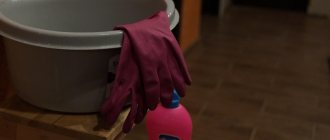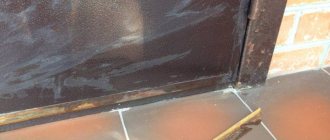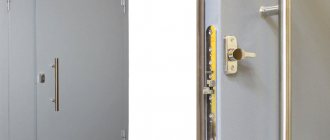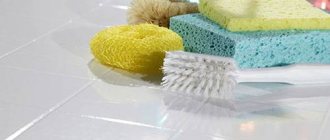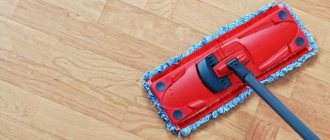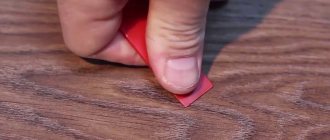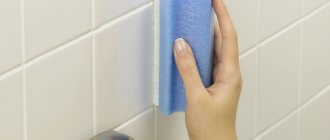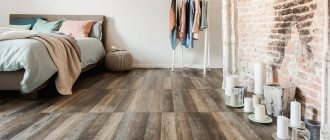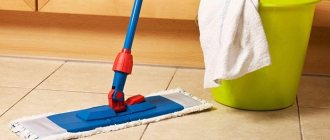One of the most durable wall and floor coverings is ceramic tiles. The use of modern technologies allows us to produce tiles from a wide variety of materials. Starting from marble and granite, and ending with artificial compounds that can compete with natural materials in strength and durability.
It is worth paying tribute to the designers. The variety of shapes, sizes and colors allows you to turn your bathroom into a real work of art. Many people do not refuse to use tiles in the kitchen. The floor and work area, finished with ceramics, are easily cleaned of dirt and retain an attractive appearance for a long time. We will talk about cleaning ceramic tiles.
Among the wide range of cleaning products that differ in composition and methods of action, it is easy to get confused. It is worthwhile to thoroughly understand how to choose the best tile cleaning product and not make a mistake.
How to clean tiles? What products can be used to clean tiles?
Every housewife probably knows a lot of ways and secrets of high-quality cleaning of the house; she is able to clean any room: hallway, bathroom, kitchen and others that are so often and heavily soiled. Tile is a covering that can be found in the dining room, bathroom, toilet, and kitchen. Caring for tiles is not difficult; you can easily achieve its shine and perfect whiteness of the “seams” between the tiles using homemade and special chemical products.
So that cleaning tiles does not take a lot of effort and time, it is important to know how to remove various types of contaminants: stains, dirt, whitewash, rust, plaque. In addition to a professional product (you choose it yourself), you should also choose the right cloth (dry or wet, wool or cotton, or a sponge).
IMPORTANT: The biggest problem you may encounter is streaks that remain even after thorough washing. They spoil the entire appearance of the tiles and create a feeling of dirt.
Why does this happen:
- The dirt was not washed out enough. This happens when the tiles were very dirty and washing did not clean them enough. Most often, dust and carbon deposits are smeared (if the tiles are kitchen).
- You washed the tiles not with clean water, but with dirty water. This happens when you try to wash a large area of tile with just one bucket of water. It should be constantly changed; used water contains dirt particles and therefore leaves stains.
- The water you used to wash the tiles is not of high quality. For example, too hard water (which contains a lot of salts) can leave characteristic white stains on the surface of the tile.
- The detergent was not sufficiently removed from the tiles. This indicates that you used too much detergent or did not rinse it well with clean water.
- You washed the tiles with a dirty rag. This happens when you wash tiles and wash them with clean water with the same rag (they need to be changed).
What stains may remain on the tiles:
- Traces of dirt
- Limescale
- Detergent residues
- Scale and traces of fat
IMPORTANT: The effectiveness of cleaning tiles depends on how correctly you choose detergents and carry out the cleaning thoroughly. Only products in an “acidic” environment can remove stains, drips and dirt - they literally corrode stains and leave a glossy shine on the surface.
People resort to “folk” cleaning methods when they do not trust chemicals or are allergic to some of their components. In addition, homemade recipes for cleaning liquids will cost you little and will be completely safe for you and your loved ones (especially children).
What and how to wash tiles?
Cleaning acrylic bathtubs
Read also: The best antiseptics for wood: how to choose a protective impregnation against fungus (Photo & Video) + Reviews 2018
Corner acrylic font
Such a font requires careful care, especially if the acrylic thickness is less than 1 mm. It is forbidden to pour hot boiling water, alcohol, formaldehyde here; it is forbidden to use metal scrapers or various solvents. To ensure that the bathtub pleases its owners with its pristine glossy shine for a long time, clean it with special gels designed for acrylic surfaces.
How to wash tiles in the bathroom, on the floor without streaks, so that they shine: detergents, tips
These products are very popular at the moment. Modern stores and supermarkets offer a huge range of different products: with cleaning granules, with pleasant fragrances, with a polishing effect, disinfectants, whitening and much more.
Most Popular:
- "Silit." The most popular product that promises to remove any dirt from tiles (as well as other surfaces) in a matter of minutes.
- Amway . _ The company offers a selection of products that are designed for cleaning kitchen tiles, bathroom tiles and toilets. The manufacturer has also developed a product (a special “active gel”) that is added to any other washing liquids (to enhance the effect).
- "Selena". An affordable and fairly cheap option for a cleaning product that can remove and combat any type of dirt on tiles (from water stains to traces of grease).
- "Hedgehog". Another “affordable” option for a low-price cleaning product. It has strong corrosive properties and is good for cleaning kitchen tiles.
- "Mr Proper ". A very popular universal product for removing dirt from any surface. The liquid is diluted in water and with the help of a well-absorbing cloth you can wipe off the tiles in the kitchen, bathroom, toilet or hallway.
Different types of tile stains and their cleaning
Prosept Multipower
Depending on the degree of contamination of the tiles, tiles and porcelain tiles, you should dilute the product correctly. Prosept Multipower is a concentrated liquid that must be diluted. And if the contamination is strong, then the solution should be made “stronger”.
Pros:
- Suitable for any type of tile;
- Effectively removes any contaminants;
- Economical to use.
How to clean bathroom tiles after renovation: products, tips
Very often, repair work leaves stains and marks on the surface of the tile. It is impossible to get rid of such problems quickly (many smudges and white deposits remain). Construction dust is considered the most harmless type of pollution, but still, you will need to know a few secrets so as not to spend a lot of time and effort cleaning it off.
How to wash off:
- First of all, try to sweep away all the debris as much as possible or vacuum the floor.
- Then wipe the floor with a dry cloth; it will wash away at least half of the construction dust.
- Dried foam or cement is best cut off with a utility knife or blade.
- After these procedures, proceed to wet cleaning with special detergents or folk remedies.
- The easiest way to achieve cleanliness is to wash the tiles with soapy water. You can use whatever you find: laundry soap, liquid dish soap, washing powder, even shower gel.
- A solution of citric acid (food grade) will help not only wash your surfaces until they shine, but also return the room to a pleasant, fresh aroma.
- Vinegar solution is the best solution for those rooms that are heavily dirty.
- If you're a chemical person, use any all-purpose cleaner or glass cleaner.
How to clean tiles after renovation?
Top 6 actions against pollution
- First:
clean minor dirt with a soft cloth; do not use a wire brush. This way you will avoid scratches and chips on the surface. Do not use abrasive cleaners! You need to be careful with acid-containing compounds. They can damage tile joints.
- Second:
try not to drop heavy things on ceramic tiles. Even porcelain tiles can crack from a strong impact. Be careful.
- Third:
do not forget about caring for floor tiles. Dry dirt and sand scratch the surface and erase it faster. Use a vacuum cleaner to remove all loose debris, then wipe the floor with a damp soft cloth.
- Fourth:
for a glossy surface, use a soft cloth and a soft brush. Avoid solutions based on organic fats and acids! They form a film and develop bacteria and mold.
- Fifth:
treat the polished surface with water-repellent agents. Perform the ritual twice a year to prevent moisture from entering the coating structure.
- Sixth:
use dirt-repellent agents for porcelain stoneware and clinker. If you clean the coating with this solution, the unglazed tiles will get less dirty.
Cleaning dirty, greasy tile floors in the kitchen: remedies, tips
The kitchen is a room that gets dirty very often. The reason for this is the constant cooking process (spilled liquids, debris falling on the floor, boiling and shooting oil, soot and scale). As a result, the tiles on the walls and floor are heavily covered with a layer of grease.
How to delete:
- You should use a product that contains alcohol or acid. They eat away fat, making it more “liquid,” which makes it easier to remove from surfaces.
- Special chemicals or alcohol will help you remove greasy deposits.
- After such cleaning, the surface can be washed with soap or all-purpose solution.
- To make the tiles shiny, they should be rubbed with glass cleaner.
How to clean tiles in the kitchen?
KIILTO CLEAN
A special acid concentrate suitable for washing glossy tiles. It will not spoil its shiny surface or scratch it. Thanks to this product, you can easily remove residual adhesive (if the tiles have just been glued), dried mortar and other complex contaminants. The product is economical to use, since it needs to be diluted due to its concentrated composition.
Pros:
- Economical concentrate;
- Removes dried glue and mortar, as well as other heavy contaminants.
Minuses:
- Requires more thorough rinsing;
- May leave whitish streaks;
- High price.
What is the best way to wash tiled, ceramic, glossy tiles, without streaks, so that they shine?
Any tile, including ceramic tiles (both glossy and matte) can be washed with household or chemical products.
What products can be used to polish tiles to a shine:
For cleaning the bathroom and toilet
Universal and professional products
Detergents and cleaning products
Different types of detergents
AMWAY LOC
This all-purpose cleaner is suitable for tiles and plumbing. The composition of the product is based on the active ingredient AMWAY LOC, which is ordinary citric acid. Thanks to such a simple composition, the product is absolutely safe for humans and the environment. It effectively removes dirt and does not leave white streaks.
Pros:
- Contains citric acid;
- Effectively removes any contaminants;
- Suitable for tiles and cleaning plumbing;
- Passed dermatological tests.
Minuses:
- Cannot be used on natural stone, marble and granite;
- High price.
What should I rub on the tiles to make them shine?
Procedure:
- Remove large debris, as rubbing the surface can scratch the tile.
- Fine dust should be removed with a dry cloth (if you have a mini vacuum cleaner or steam generator, also use it).
- After this, you can begin to cleanse from dirt or grease; for this, choose any suitable product.
- Rub the tiles with a special alcohol-containing polish or a dry cloth (until the desired shine and gloss appears).
- If you wash off the whitewash, you will have to wash the surface several times, changing the water each time and rub it with a dry, clean cloth.
Cleaning tile joints
The grout that fills the seams between the tiles darkens over time, becomes covered with brown stains, and fungus loves to settle in it - both green and the most dangerous black.
When cleaning the kitchen daily, the seams are washed well, but if cleaning is not done every day, the kitchen becomes very untidy. What can help in this case?
Reference. To deeply clean the surface, you can use either a toothbrush with stiff bristles (you can buy the cheapest new one or use an old, unnecessary one), or a melamine sponge, or a special brush for tiles.
The cleaning products used are the same as for tiles, but to prevent the appearance of mold and remove existing mold, you should use a mixture of soda, water and vinegar.
Too acidic solutions can slightly “loose” the solution inside the joints, so there is no need to pour a lot of vinegar into the water.
It is also strictly forbidden to use very hard bristles on brushes and metal sponges - they not only scratch the gloss, but also wash out parts of the solution from the seams.
After such “cleaning”, mold and dirt will eat into it even more and it will become impossible to wash them off.

